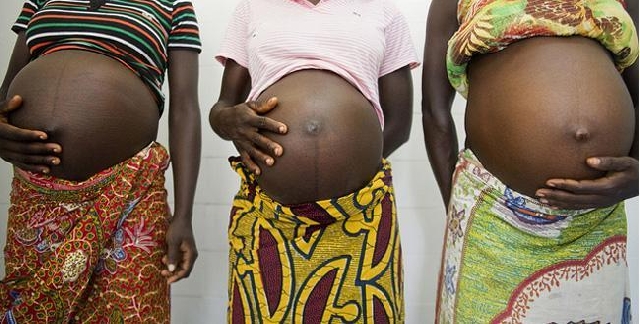Teenage pregnancies in Ghana hit 555,575 in five years
 File photo of pregnant teens
File photo of pregnant teens
More than half a million teenagers are on record to have gotten pregnant over the last five years, data from the Ghana Health Service District Health Information Management Health System (DHIMS) reveals.
Between 2016 and 2020, about 555,575 teenagers aged 10 to 19 years, are said to have gotten pregnant.
Within the five years, 13,444 teenagers between the ages of 10 and 14 got pregnant, while some 542,131 teenagers aged 15 to 19 years got pregnant.
On average, a little over 112,800 teenagers get pregnant annually.
Breakdown of 10 to 14-year-olds’ pregnancies
The annual breakdown for pregnancies involving 10 to 14-year-olds is: in 2016, about 2,325 cases were recorded; in 2017, some 2,585 teenagers got pregnant; and in 2018, the figure increased to 2,968 but reduced to 2,856 pregnancy cases in 2020.
From 2016 to 2020, the Ashanti region recorded 2,165 cases of pregnancies among teenagers under 14. The Eastern region followed with 1,528 cases. Central region recorded some 1,327 cases.
In Greater Accra, some 1,247 pregnancies were recorded. The Western region also recorded 1,156 cases while the Bono East region recorded 881 cases.
Volta region saw some 810 girls under 14 years getting pregnant over the five-year period. The Bono region also recorded some 766 cases.
The Northern region had some 595 pregnancies while the Upper East region followed with 575 cases.
The North West region also recorded 523 pregnancies. Oti region saw some 448 teenagers aged 10 to 14 getting pregnant over the period under review.
Some 434 cases were recorded in the Savannah region, and about 386 teenagers under 14 years also visited the hospital for antenatal checks in the Upper West region.
The Ahafo region and the North East region recorded some 321 and 282 cases respectively in the period under review.
Ashanti – 89,856
Over the last five years, the Ashanti region has recorded 89,856 teenage pregnancy cases. Out of this, a total of 18,461 were recorded in 2016.
This figure dropped in 2017 and 2018 with 18,066 and 17,447 cases respectively.
This trend was bucked in 2019 when the number of teenage pregnancy cases shot up to 18,080.
It, however, saw a decline in 2020 when the number of cases recorded reduced to 17,802.
Eastern – 56,730
Between 2016 and 2020, the region recorded some 56,730 teenage pregnancies.
The report from DHIMS indicates that out of this, 1,528 teenagers were between ages 10 and 14 years while 55,202 were between the ages of 15 and 19 years.
In 2016, the Eastern region recorded 11,968 cases, which represented 14 per cent of the total number of pregnant women that visited the hospital.
It was recorded that about 84,851 pregnant women visited hospitals in the region in 2017. Out of it, some 11,639 pregnant visitors were teenagers.
The figure declined to 11,007 and 10,989 in 2018 and 2019 respectively. In 2020, some 10,865 teenagers also got pregnant.
The region saw a reduction in cases from 2017 to 2020.
Central – 56,443
The region saw some 438,761 women visiting hospitals for antenatal checks over the last five years. A report from DHIMS shows that out of the figure, about 56,443 were teenagers.
Some 1,327 of them were between the ages of 10 and 14 years while 55,116 were aged 15 to 19 years.
In 2016, 12,404 teenagers engaged in early sex, leading to pregnancy. In 2017, about 11,474 teenagers got pregnant, and in 2018, some 11,350 young teenagers were also impregnated.
In 2019 and 2020, the region recorded 10,914 and 10,301 cases of teenage pregnancy respectively.
Northern – 43,533
The region recorded about 43,533 pregnancy cases over the last five years. In 2016, about 8,274 teenagers visited the hospital for antenatal checks.
This figure increased in 2017, with some 8,354 teenagers between the ages of 10 and 19 recorded to have gotten pregnant.
In 2018, the number of teenage pregnancy cases was 8,832. Even though the region saw a decline in numbers in 2019, it increased rapidly in 2020.
The number of cases recorded moved from 8,824 in 2019 to 9,249 in 2020.
This was the year the country was strongly hit by the pandemic and as such all business activities were put on hold and people, including teenagers, were required to stay home.
Greater Accra – 49,356
Within the five-year period, DHIMS reported that about 1,247 teenagers aged 10 to 14 got pregnant while some 28,109 teenagers between the ages of 15 and 19 got pregnant.
Out of these numbers, about 10,017 teenagers got pregnant in 2016. The number reduced in 2017 to 9,912 cases.
In 2018, there was an increase in cases, with 10,210 teenagers visiting the hospital for antenatal checks.
In 2019 and 2020, the region recorded 10,199 and 9,018 cases respectively, indicating a decline over the two-year period.
Western – 43,921
The region recorded 43,921 over the five-year period. The data showed that about 1,156 teenagers aged 10 to 14 got pregnant while data on teenagers between the ages of 15 and 19 recorded 42,765 cases.
In 2016, about 9,127 cases were recorded. Out of this, about 8,906 were between ages 15 and 19. In 2017, the region saw a decline in numbers as some 9,070 teenagers pregnant.
In 2018 and 2019, the figure further reduced to 8,702 and 8,489 cases respectively. However, the number of cases increased to 8,533 in 2020.
Upper East – 30,444
The Upper East region, which recorded 30,444 teenage pregnancy cases over the last five years, had its cases increasing year on year.
Even though the number of cases reduced in 2018, it’s been on the rise in subsequent years.
In 2016, the region recorded 5,589 teenage pregnancy cases.
In 2017, the region saw an increase in the number of cases. The data from DHIMS indicated that the region recorded 6,187 cases in 2017.
This figure reduced in 2018 to 5,902. However, from 2019, teenage pregnancy cases increased from 6,233 to 6,533 in the year 2020.
Bono East- 28,284
With over 28,000 cases recorded over the last five years, the region recorded 5,394 teenage pregnancy cases in 2016.
In 2017 and 2018, the number of cases inched up from 5,602 to 5,797.
It should be noted that the number of teenage pregnancy cases has remained within the 57,000 range in the subsequent years.
In 2019, the region had 5,750 teenage pregnancy cases while about 5,741 teenagers got pregnant in 2020.
Bono – 22,944
The Bono region recorded 22,944 teenage pregnancy cases. In 2016, the region saw 5,394 teenagers who conceived.
In 2017 and 2018, some 5,602 and 5,797 teenagers between the ages of 10 and 19 became pregnant respectively.
In 2019, about 5,750 teenagers were impregnated.
In 2020, the figure decreased to 5,741 cases.
Out of the total amount of teenage pregnancies recorded in the region over the last five years, 881 were said to be between the ages of 10 and 14 while 27,403 were aged 15 to 19.
Oti – 19,248
Looking at the number of teens who got pregnant in this region, the report records 19,248 cases over the last five years.
Out of this, some 8,274 cases were recorded in 2016.
In 2017, 8,354 teenagers became inseminated, and in 2018, 3,641 teenage pregnancy cases were recorded.
In 2019, some 3,724 teenagers visited hospitals in the region with baby bumps, and in 2019, about 3,970 expectant teens were recorded to have visited the hospital.
North East – 16,695
A total of 16,695 teenage pregnancies were recorded in the region.
In the five years under consideration, 2020 recorded the highest number of cases.
While some 3,037 teenagers were pregnant in 2016, about 3,602 teenagers also got pregnant in 2017.
This figure reduced in the subsequent years to 3,331 and 2,945 in 2018 and 2019 respectively.
However, in 2020, during the coronavirus pandemic, associated with a lockdown and economic difficulties, about 3,780 teenagers visited the various health facilities in the region for pregnancy-related care.
Savannah – 16,601
In this region, 16,601 teenage pregnancy cases were recorded.
Out of these cases, 16,167 were aged 15 to 19 and 434 were between 10 and 14. The region has seen a consistent increase over the last five years.
In 2016, some 3,261 teenagers were impregnated.
This figure increased in 2017; the year saw some 3,325 teenagers visiting hospitals in the region for antenatal care.
In 2018 and 2019, some 3,102 and 3,397 cases were recorded respectively.
In 2020, these figures rose to 3,516, representing 14.3 percent of teenage pregnancy cases recorded nationwide.
Western North – 20,101
The Western North region saw 4,184 teenage pregnancy cases in 2016.
In 2017, it increased to 4,349 cases.
This, however, reduced to 4,070 in 2018.
This downward trajectory failed to continue, with 3,748 and 3,750 pregnancies recorded among girls in the region in 2019 and 2020 respectively.
Upper West – 18,225
In this region, 386 teenagers between the ages of 10 and 14 got pregnant while some 17,839 teenagers aged 15 to 19 carried babies.
In 2016, 3,473 teenagers were recorded to have gotten pregnant while 3,684 others also got pregnant in 2017.
In 2018, about 3,726 teenagers showed up at the hospitals in the region with pregnancy bumps while 3,759 cases were recorded in 2019.
However, in 2020, the number of cases decreased to 3,583 in the region.
Volta – 30,333
The Volta region had some 29,523 teenagers aged 15 to 10 getting pregnant over the five-year period. Also, some 810 pregnant teenagers between the ages of 10 and 14 were recorded.
The year 2016 saw 6,213 teenagers carrying baby bumps in the region. This reduced to 6,211 in 2017.
In 2018 and 2019, about 5,861 and 5,904 teenage pregnancy cases were recorded in the region respectively.
The region continually saw a reduction in the number of cases till 2020, where the figures shot up to 6,144.
Ahafo – 12,861
The Ahafo region recorded 12,861 cases within five years.
Out of this, 321 were children aged 10 to 14 while 12,540 teenagers were between the ages of 15 and 19.
In 2016, 2,600 teenagers got pregnant, and in 2017, some 2,491 teenagers were seen carrying baby bellies.
About 2,590 teenagers got pregnant in 2018 while 2,555 teenagers aged 10 to 19 also got pregnant in 2019.
In 2020, some 2,625 visited hospitals in the region with baby bumps. This was an increase in the number of cases compared to previous years.
Decrease in cases over the last five years
Trends from the DHIMS data indicate a reduction in the number of cases over the past five years.
In 2016, about 11.8 percent of pregnancies recorded in the country belonged to teenagers. In 2017, the number of cases increased to 11.9 percent out of the total number of registered pregnant women.
In 2018, the figure dropped to 11.7 percent, with no change being recorded in 2019. There was good news in 2020 as the country saw a marginal reduction to 11.2 percent.
Even though numbers in some regions decreased as the years went by, the figures are still alarming.
The government, through its ‘Back-To-School Campaign’, has currently instituted measures to reduce teenage pregnancies and school dropouts.
The Ghana Education Service (GHS) has ensured that when school teens get pregnant, teachers, together with school heads, build rapport with the girl-child to get more information and provide them with the needed counsel.
According to the report on ‘Prevention of Pregnancy & Re-Entry of Young Mothers’ by the GES, schools must document teenage pregnancy cases and discuss implications for all the stages of pregnancy for boarding/day students.
The GES’ position on teenage pregnancy prevention has always been on promoting abstinence among school girls.
It has also collaborated with parents to provide supervision at home and in school.
As a result of these measures to facilitate the re-entry of teenage mothers to school, the GES has recorded some 2,720 girls returning to school after childbirth in the 2017/2018 academic year.
According to the 2019 report from Educational Management Information System (EMIS), 3,212 teenagers went back to school in the 2018/2019 academic year.
However, due to COVID-19, data collection and processing for the 2019/2020 academic year have delayed.
Way forward
Considering these signs of progress, the GES suggests that there must be continuous support in regional, district and community level engagements with other stakeholders to help reduce and prevent teenage pregnancies.
The report also suggests that there must be engagement with the media to support the dissemination process to prevent teenage pregnancies.
“Every platform must be used to sensitize and encourage the community to send their children back to school,” the GES stressed.
Source: The Finder
Trending News

NACOC to step up surveillance at entertainment joints during festive season
05:28
Agona Swedru Fire Service takes fire safety education to the streets
06:09
Legal Education Reform Bill, 2025 details miscellaneous and transitional provisions
09:57
Asantehene's mediation efforts on Bawku conflict praised by Progressive Alliance of Ghana
09:40
Minister for Interior unveils new National Signals Bureau Regional Command in Sunyani
04:12
Supreme Court affirms Alpha Beta Education Centre’s title to Akokorfoto lands
05:59
Festive season fare hikes deepen commuter woes in Accra
09:46
Nationwide fire extinguisher verification for vehicles begins today — GNFS
09:31
Ghana National Fire Service responds to mass breathing difficulty incident at CMB
04:58
A time is coming, we will have a female IGP- Prophet Ask-Ackrong
21:18



